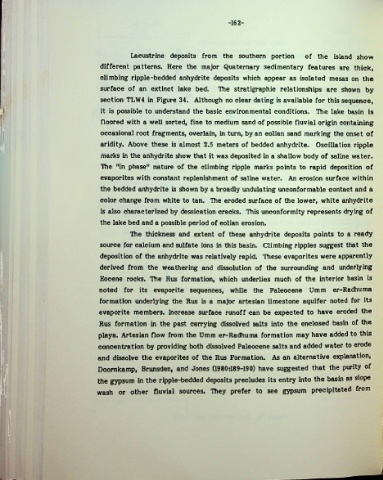Page 186 - Life & Land Use on the Bahrain Islands (Curtis E Larsen)
P. 186
1
-162-
Lacustrine deposits from the southern portion of the island show
different patterns. Here the major Quaternary sedimentary features are thick,
i
climbing ripple-bedded anhydrite deposits which appear as isolated mesas on the
surface of an extinct lake bed. The stratigraphic relationships are shown by
section TLW4 in Figure 34. Although no clear dating is available for this sequence,
it is possible to understand the basic environmental conditions. The lake basin is
floored with a well sorted, fine to medium sand of possible fluvial origin containing
occasional root fragments, overlain, in turn, by an eolian sand marking the onset of
aridity. Above these is almost 2.5 meters of bedded anhydrite. Oscillation ripple
marks in the anhydrite show that it was deposited in a shallow body of saline water.
The "in phase" nature of the climbing ripple marks points to rapid deposition of
evaporites with constant replenishment of saline water. An erosion surface within
the bedded anhydrite is shown by a broadly undulating unconformable contact and a
color change from white to tan. The eroded surface of the lower, white anhydrite
is also characterized by dessication cracks. This unconformity represents drying of
the lake bed and a possible period of eolian erosion.
The thickness and extent of these anhydrite deposits points to a ready
source for calcium and sulfate ions in this basin. Climbing ripples suggest that the
deposition of the anhydrite was relatively rapid. These evaporites were apparently
derived from the weathering and dissolution of the surrounding and underlying
Eocene rocks. Tlie Rus formation, which underlies much of the interior basin is
noted for its evaporite sequences, while the Paleocene Umm er-Radhuma
formation underlying the Rus is a major artesian limestone aquifer noted for its
evaporite members. Increase surface runoff can be expected to have eroded the
Rus formation in the past carrying dissolved salts into the enclosed basin of the
playa. Artesian flow from the Umm er-Radhuma formation may have added to this
concentration by providing both dissolved Paleocene salts and added water to erode
and dissolve the evaporites of the Rus Formation. As an alternative explanation,
Doornkamp, Brunsden, and Jones (1980:189-190) have suggested that the purity of
the gypsum in the ripple-bedded deposits precludes its entry into the basin as slope
wash or other fluvial sources. They prefer to see gypsum precipitated from

